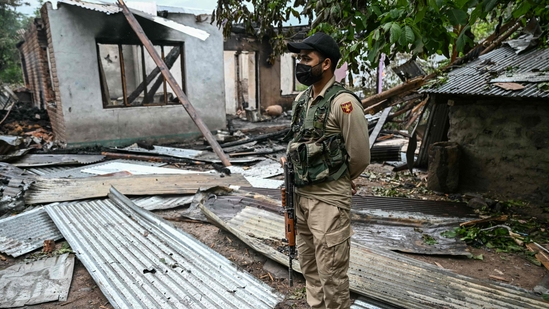Pakistan Shells LoC After India Neutralizes Drone, Missile Attacks: Top 10 Updates

Pakistan Shells LoC After India Neutralizes Drone, Missile Attacks: 10 Major Updates
In a significant escalation along the Line of Control (LoC), Pakistan resorted to heavy shelling on Thursday, just hours after India successfully intercepted and neutralized drone and missile attacks. This series of events has once again brought the spotlight to the fragile peace between the two nuclear-armed neighbors.
While India showcased strong defense capabilities, Pakistan’s provocation has triggered widespread concern. Let’s explore the top 10 updates to understand the situation better.
1. Pakistan Launches Heavy Shelling Across LoC
According to defence sources, Pakistan Army initiated intense shelling using heavy artillery and mortars in multiple LoC sectors, including Poonch, Rajouri, and Kupwara. The barrage began late Wednesday and continued into Thursday morning.
Consequently, several Indian border villages witnessed widespread panic, and civilians had to be moved to safety. Authorities are assessing damage to residential buildings and farmlands.
2. Indian Forces Respond with Precision Retaliation
In response, the Indian Army retaliated with high-precision artillery fire, targeting Pakistani posts responsible for initiating the attack.
Furthermore, Indian troops ensured that their retaliation was measured yet effective, aiming to prevent civilian casualties on both sides while neutralizing threats efficiently.
3. Drone and Missile Threats Intercepted by India
Earlier in the day, Indian air defense units intercepted multiple drones and incoming missiles along the northern borders. These threats, launched from across the LoC, were identified and neutralized mid-air.
Meanwhile, officials confirmed that India’s early warning radar and anti-aircraft systems played a key role in stopping what could have been a much larger threat to national security.
4. Civilian Injuries and Property Damage Reported
Unfortunately, the shelling caused injuries to at least five civilians, including a child who is currently undergoing treatment in Jammu.
In addition, several homes were damaged, and livestock casualties were reported. Relief and rehabilitation teams have been deployed to provide emergency support in the affected areas.
5. Indian Government Holds High-Level Security Meeting
Reacting swiftly, the Government of India convened a high-level security meeting led by Defence Minister Rajnath Singh. Home Minister Amit Shah and National Security Advisor Ajit Doval were also briefed.
During the meeting, officials reviewed border security protocols and discussed both military and diplomatic options to address the situation.
6. Air Force on High Alert Across Northern Commands
Simultaneously, the Indian Air Force (IAF) raised its alert levels across all northern bases. Fighter aircraft were seen conducting aerial patrols, and drone surveillance was intensified to track any potential threats.
Moreover, all airbases in sensitive zones were instructed to maintain full combat readiness.
7. Pakistan Accused of Supporting Terror Infiltration
In addition to military actions, Indian intelligence sources have accused Pakistan’s Inter-Services Intelligence (ISI) of supporting infiltration by terror groups under the cover of shelling.
As a result, multiple infiltration attempts were reported in the last week, including failed bids in the Machil and Keran sectors. Indian soldiers remain on heightened alert to prevent any breach.
8. International Community Expresses Concern
The international community has responded with concern. The United Nations and the United States have both urged India and Pakistan to exercise restraint.
Specifically, a UN spokesperson emphasized the importance of peace and dialogue. Meanwhile, the U.S. State Department called for immediate de-escalation to ensure regional stability. You can read the UN’s official statement on UN News.
9. Political Reactions from India
Back home, political leaders strongly condemned Pakistan’s actions. While BJP leaders described the attack as “cowardly,” opposition parties, including Congress, backed the government’s firm stance.
Consequently, there appears to be broad political consensus that national security must remain a top priority, regardless of party lines.
10. Ground Reality in Border Villages
Meanwhile, life in border villages remains tense. Schools have been closed, shops shuttered, and people are taking refuge in underground bunkers and relief camps.
Despite this, many residents continue to show remarkable courage and resilience. One villager said, “This isn’t new for us. But every time it happens, it takes a part of our peace away.”
Local NGOs and administration officials are coordinating relief efforts, ensuring food and medical support reach the displaced.
What This Means for the Future
Clearly, the situation at the LoC is deteriorating. While India has demonstrated military strength and restraint, the continued provocations by Pakistan may lead to more serious confrontations.
Therefore, both military preparedness and diplomatic engagement will be crucial in the days ahead. The coming week could be pivotal in determining whether this conflict escalates or moves toward a temporary resolution.
Final Thoughts
The recent wave of aggression — starting with Pakistan-backed drone and missile attacks, followed by heavy shelling — is a dangerous reminder of the challenges along the LoC. India’s swift response has showcased its defense preparedness, but the impact on civilians and the risk of wider conflict remain concerns.
As the world watches, India stands firm, ready to protect its borders. However, peace in the region can only be achieved if Pakistan refrains from supporting terror elements and respects the ceasefire agreements already in place.






